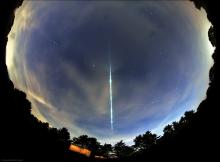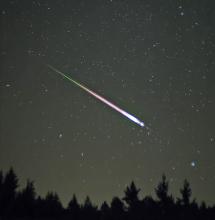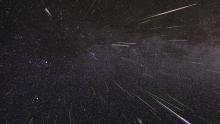Listen to today's episode of StarDate on the web the same day it airs in high-quality streaming audio without any extra ads or announcements. Choose a $8 one-month pass, or listen every day for a year for just $30.
You are here
Daytime Shower
When the Sun rises, the rest of the universe vanishes. Scattered sunlight turns the sky blue, erasing the stars and planets from view.
The curtain of blue also hides meteors — the streaks of light formed by bits of space rock burning up as they plunge into the atmosphere. Just as many meteors flash through the daytime sky as the nighttime, including several meteor showers. And one of the most intense should be at its peak tomorrow.
The Daytime Sextantids are spawned by an asteroid. It may have split from the parent body of December’s nighttime Geminid shower, which is one of the year’s best. When Earth crosses the asteroid’s path at this time of year, though, the dayside of our planet is facing into the cloud of debris, so the meteors are washed out.
Astronomers track the meteors with radar. The meteors leave trails in the upper atmosphere that reflect radio waves. Astronomers use observations of those reflections to trace the paths of the meteors, and track down their parent asteroids.
There are two ways for the rest of us to observe the shower. You can look for the meteors in the hour or so before dawn, low in the eastern sky.
Or you can “listen” for them. A meteor’s trail reflects FM radio waves. If you have an FM radio, tune to a weak station at the low end of the band. When a meteor passes by, the signal should become louder and clearer for a few seconds — the sound of a “shooting star.”
Script by Damond Benningfield






